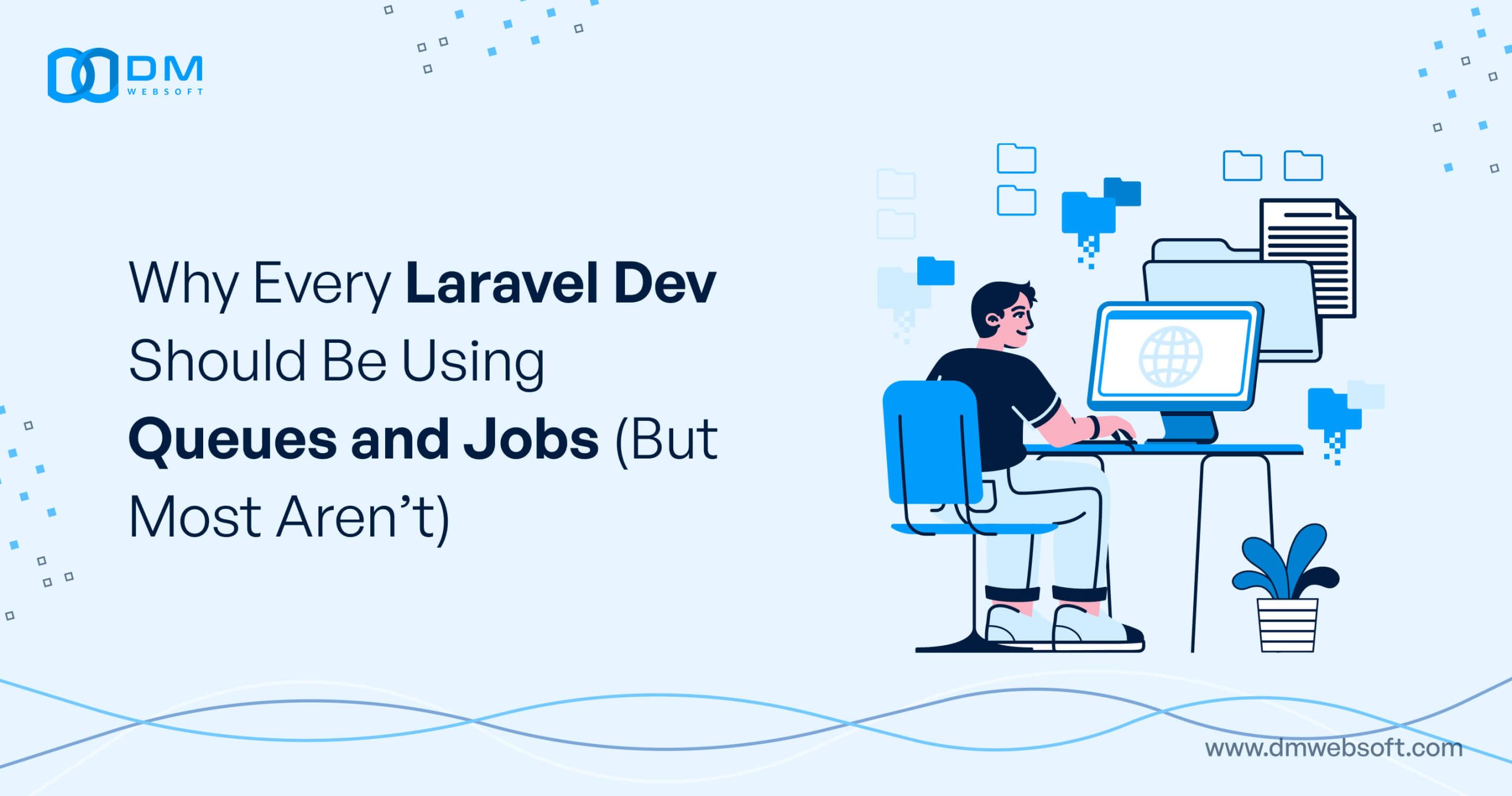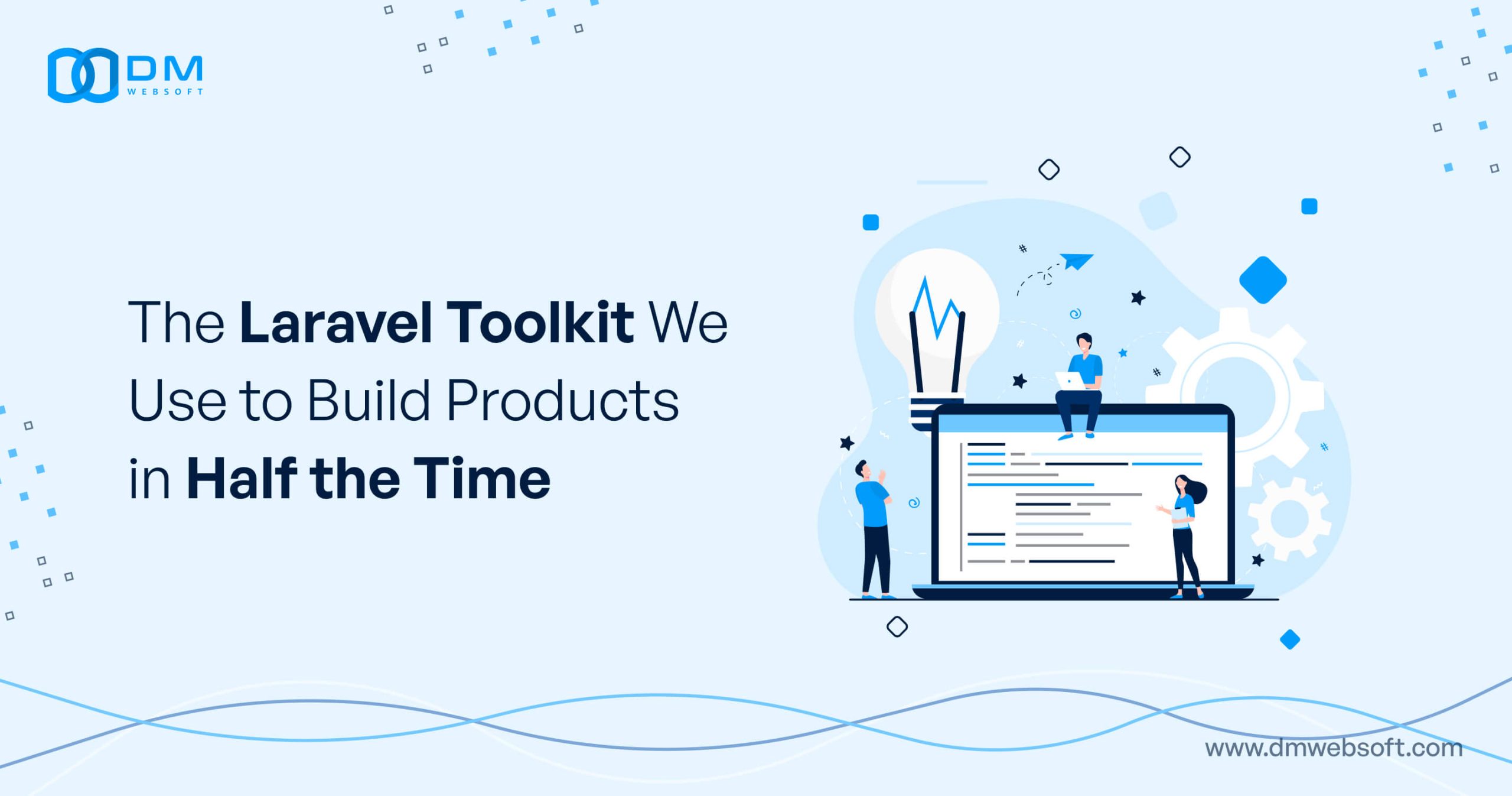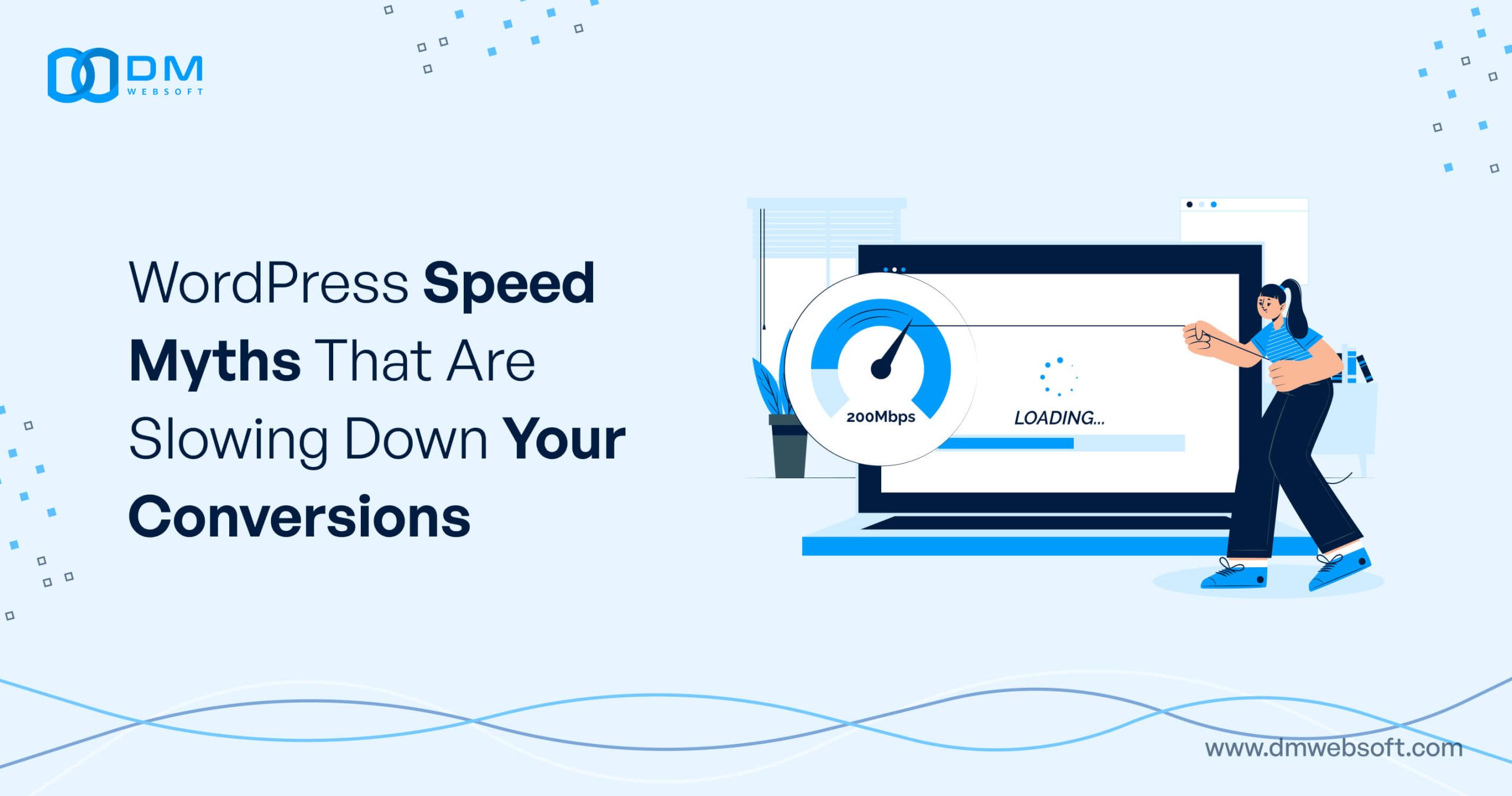DM WebSoft LLP exceeded our expectations! Their seasoned team of experts delivered a website that perfectly captures our brand essence. Their 15+ years of experience truly shine through in their exceptional web development skills.
Progressive Enhancement vs. Graceful Degradation in Modern Web Design

TABLE OF CONTENT
Introduction
Understanding Progressive Enhancement and Graceful Degradation
The Significance of Progressive Enhancement in Web Design
Exploring Graceful Degradation and Its Role
Strategic Implementation in Web Development
Real-Life Case Studies
The Future of Web Design Strategies
DM WebSoft LLP's Approach to Modern Web Design
Call to Action
Conclusion
Get in Touch
Introduction
Out of these two schools of thought—Progressive Enhancement and its counterpart, Graceful Degradation—emerged the guiding lights of the continually changing web design and development landscape, for the making of accessible, functional, and visually appealing websites. These strategies, at odds as they may seem, do share the same goal: getting the most of the user experience, regardless of his device capabilities or browser.
In other words, Progressive Enhancement goes as follows: you lay down a solid foundation of basic content and functionality, like a building might be first built with a solid foundation, and only then you add rich layers of visual polish and interactive flair for the browsers that can support such, just like other decorative architectural elements might be added later. Such an approach would also mean that all and sundry, notwithstanding the limitation that technology imposes, can access with ease the core content and services the site offers.
In other words, graceful degradation works the opposite way: it starts with all the complete sets of functions and designs intended to work for the newest browsers and devices, then slowly tapers them down or modifies them for older technologies. Build the most modern building that you could, designing in such a way that people of all kinds of abilities would still be able to get in and use the basic facilities, even if they couldn’t avail themselves of every bit of convenience that you’ve designed for the building.
The use of Progressive Enhancement or Graceful Degradation is not in the theoretical discussion; it is, in fact, the discussion that demonstrates real problems and good sides that web development has. The present blog post is going to dive deeper into these strategies, explaining the importance and really giving insights into the way that business—especially the ones that use the expertise of DM WebSoft LLP—can really benefit from strategic implementation. This understanding would, therefore, appreciate the nuances of modern web development and design, providing a more inclusive and effective way for online presence.
Having a look at that, now it is time to get into great detail about these great strategies of web design and first of all get started on definitions, historical context, and some main key differences.
Understanding Progressive Enhancement and Graceful Degradation
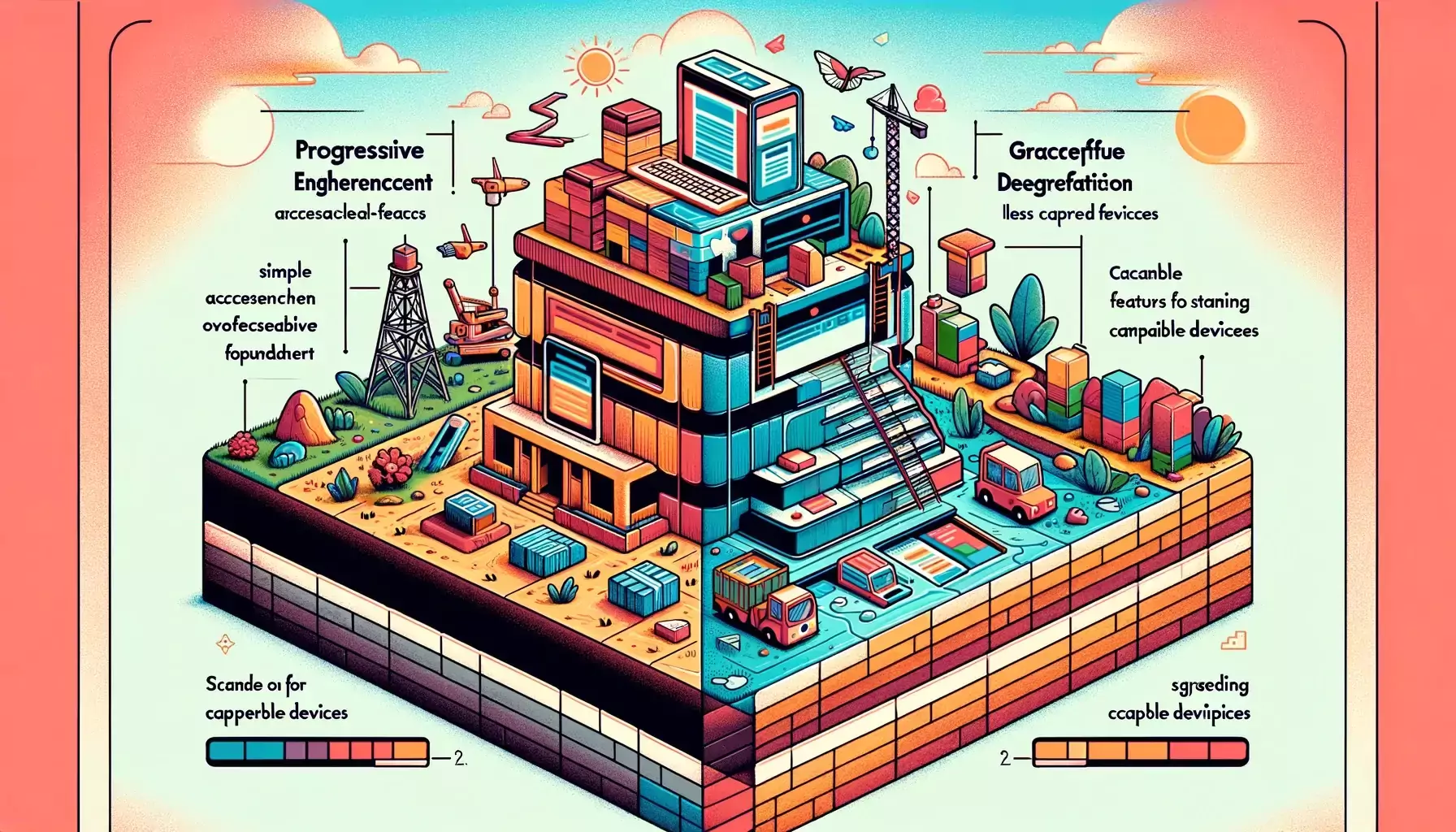
The web is always in flux, making it a very fast-paced technology and user-requirements field. Designers and developers have to do a lot of guesswork, puzzle out, and find their way through a minefield in a bid to get their websites accessible and to function for all the people using different devices and browsers. The core of this challenge is the two key strategies: Progressive Enhancement and Graceful Degradation. They propose two different paths that are in open opposition but both aiming at the same ideal of providing the best possible user experience considering the technical limitations. Next comes the definitions, differences, and historical development of these key concepts of web design.
Progressive Enhancement: Building Up from a Solid Base Definition and Approach
Progressive Enhancement is a strategy beginning with the most basic layer of a website’s functional base, focusing on ensuring the content accessed is available to all users, regardless of browser capabilities, or the lack of presence of avant-garde features.
So it will further develop more sophisticated layers of interactivity and design, but it will target only browsers and devices that really allow it space. Think of it as building a house—one in which you first get that core structure completely solid and functional, and only then do you start to put fancy decorations on top of that structure.
Core Principles
In other words, it is a core ensuring that the content is available to any people who might have a disability or are using assistive technologies.
- Content-First: This model implies the approach of considering content with higher priority than design; in other words, no ideas about excruciating design are considered until the message requires being clear and accessible without advanced styling or scripting.
- Layered Experience: Experience for all users with the simple devices is functional and complete. For users with advanced capabilities, it includes advanced interaction and aesthetic features.
Graceful Degradation: Preparing for a Step Down
Definition and Approach: The approach is a complete opposite of the one that has been previously discussed; that is, graceful degradation. The designing actually starts from the most recent and the best browsers, resulting in having all the bells and whistles part of the design.
If that is not possible, then the strategy downgrades the experience, still making the site usable, but without some of the advanced features, for such things as older browsers or other less capable devices. It’s like building a super expensive and complex smart home but at least having basic functionality, even if all the smart features are turned off.
Core Principles
- Forward-Thinking Design: Focuses on using the newest technologies to create cutting-edge web experiences.
- Fallback Solutions: Provides fallbacks for older browsers, so while some users may not view the website in all its glory, they can still access essential functionalities.
- Balancing Act: Striving to balance innovation with accessibility, making sure that the adoption of new technology does not alienate them from the equipment they currently use.
Historical Context and Evolution
Concomitantly with its rise came two opposing doctrines along the web design field, to say, Progressive Enhancement and Graceful Degradation. In the very nascent stages of web design, developers often had a battleground in their heads over whether to embrace new technologies to push the bar forward or stick with older tried-and-true standards for ensuring wide access to the site.
As web standards developed and the range of internet-enabled devices grew, these strategies became more nuanced.
- Early Internet: This was the time that was associated with great emphasis placed on content delivery—with little concern for design or advanced functionality.
- The Rise of Web Standards: As the web started to grow, a movement towards the use of standardized technologies and practices urged a more organized approach to web development and laid down the basics for the following strategies.
- Explosion of mobile internet usage: This drastic expansion of mobile internet usage brought some complexity to the design considerations, which makes it more relevant to consider Progressive Enhancement as a mobile-first strategy, while Graceful Degradation ensured that the desktop experiences were rich and engaging.
Key Differences However, while both Progressive Enhancement and Graceful Degradation aim at providing universally accessible and functional web content, they have different starting points and philosophies.
Basic: Starting from the basic, universally compatible level of the site, Progressive Enhancement builds up to advanced, while Graceful Degradation starts with the most advanced and works down to the most basic.
Progressive Enhancement is accessibility-oriented from the beginning, while Graceful Degradation focuses on a fully engaging experience, tuning for what needs to be tuned to provide the best user experience in more capable environments.
This is knowledge that is key for any web designer or developer looking to create web experiences that are inclusive, effective, and future-friendly. As web technology advances, the meeting between Progressive Enhancement and Graceful Degradation stands as yet another tribute to the commitment this medium has to accessibility, usability, and innovation.
The Significance of Progressive Enhancement in Web Design

In the world of design and development for the web, progressive enhancement is much more than just a strategy; it is a philosophy towards universal usability and accessibility. Its importance goes much beyond the strictly pertinent issues of compatibility, influencing the way users conceive the content that the web encloses in a legion of devices and browsers. This literally means ensuring that the core content and functionality of the website are available to everyone, from users on high-speed broadband connections to those with limited Internet access and old browsers. Let’s delve into why Progressive Enhancement is a cornerstone of modern web design.
Ensuring Universal Accessibility
But truly, at its core, Progressive Enhancement is user-focused: whoever and however people are accessing the Internet. That is to say, from the outset, it should be content available to all users, and then it overcomes extra styling and functionality for users having more advanced browser abilities. This type of inclusivity is, therefore, not only a best practice but a must in a world where access to the internet is drastically varying between and within regions.
Enhancing User Experience Across Devices
It continues with the introduction of dynamic designs with the advent of smaller screens in smartphones and larger screens in tablets. And with Progressive Enhancement, it simply gives a designer an easy way to make experiences accessible and optimally designed for screens of all sizes. That is useful for the mobile users since they commonly have less bandwidth and slow connections. This will provide them with content and function designed for mobile devices without further overhead.
Improving Performance
Sites built with Progressive Enhancement in mind are usually faster in loading, even in fewer capable devices or connections. It focuses on getting core content and functionalities, so users are not waiting up for the loading of heavy scripts or big images with high resolution.
This performance boost is crucial for retaining visitors, as slow-loading sites lead to higher bounce rates.
Boosting SEO Naturally, search engines would rank high websites that load fast and give quality content to users from whatever device they are accessing the site. And this jells well with the aims of Progressive Enhancement, which basically has to do with focusing on content accessibility and semantic HTML markup. This would go along the way in improving the search engine ranking of the site and, therefore, more visibility to most potential users.
Case Studies Highlighting Its Impact For example, the bounce rate fell by 40%, and the conversion rate grew by 25% upon the redesign of the travel agency website according to the Progressive Enhancement principles. As a result, the travel agency website developed accepted the responsive design principle and adopted image and code optimization that helps in improving not only user engagement but also the business metrics.
Building Social Project: this was a redesign of a social media platform showing how Progressive Enhancement could increase their rates of engagement. It provided a baseline but functional experience for all users, with extra interactivity for users who had JavaScript enabled—demonstrating how Progressive Enhancement can be flexible, offering many different ways of crafting engaging user experiences.
Embracing Future Web Trends
New web standards, APIs, and design trends that appear in the future will be incorporated into the progressive enhancement framework to make the website the latest and yet accessible by every user. This adaptability makes Progressive Enhancement a future-proof strategy that can evolve with the web. More than just a web design technique, Progressive Enhancement is informed by the spirit and essence of the web itself: universal access. Help them improve the user experience from day one because they will be building sites that serve the largest possible audience and not targeting specific ones. This will, therefore, ensure that the digital world is inclusive and fair.
Exploring Graceful Degradation and Its Role

Contrariwise, if we do want to make them consistent across the board, the latest functionalities and aesthetic trends can amply improve the user experience in the case of Graceful Degradation. It is from the onset high-tech-oriented, merging state-of-art functions and designs with keeping an eye on the website’s functionality on older platforms and in browsers. This section presents the reason for Graceful Degradation, its application in a practical sense, and, most importantly, the significance of ensuring that the wider accessibility and usability be enforced so that it stands first among the diverse landscapes of the web users.
The Rationale Behind Graceful Degradation That’s the way machines, both up-to-the-minute smartphones and laptops with the latest browsers, and old desktops running archaic software, browse the Internet. Graceful Degradation should therefore always be sensitive to such diversity and strive to accommodate a website environment in which users with any technology and ability can access content and essential functionalities, even if it does have the result of some users not experiencing the site in its full glory.
This approach focuses more on giving users access to the content rather than assuring similar experiences across all platforms.
- Forward Compatibility: It is a mechanism that will ensure, in the safeguarding of users’ experience, the websites will still be working while the new devices and browsers are being developed in future technological advancements.
- User reach: Allowing businesses to reach a wider number of people, the majority of whom might not be using newer devices and browsers.
Practical Applications of Graceful Degradation
Graceful Degradation appears through some web development practices that ensure they give fallbacks or alternatives in the cases whereby some technologies are not supported.
For example, a website could use modern CSS Grid layouts but serve a fallback to Flexbox or floated elements for Grid-incompatible browsers.
Advanced JavaScript functionality will, therefore, degrade in a graceful manner to simpler interactions or static content if browsers are not in a position to execute the scripts for users.
- Fallback Styles: Using simpler styling that is compatible with older browsers when advanced CSS features fail. Scripting Safeguards: Ensuring websites remain navigable and content accessible, even without JavaScript enabled.
- Images and Multimedia Handling: alternative texts for images or providing alternative multimedia environments that would be able to provide a simplified version of multimedia content in case the environment could not support original multimedia formats.
The Significance of Graceful Degradation
Graceful Degradation does not propose to give way to innovation or deployment of new technologies. It is the idea of embracing progress but holding on to the notion of having an inclusive internet. The reasons this balance must be struck include:
- Inclusiveness and Accessibility: Design practices should be aimed at designing inclusiveness and accessibility—i.e., enabling the possibility of users with old or less capable devices to access important information and services.
- SEO Benefits: The search engines absolutely love a friendly display of the content and general user experience on all devices—even older technologies.
- Brand perception: If nothing else, at least proving to them that they are valued by the brand and that they do not need to have the latest technologies at all times can increase brand loyalty and perception.
Graceful Degradation is a reminder that progress must not house alienation or exclusion within today’s blisteringly hot digital environment. Instead, it should be a step forward that considers the past, present, and future of web accessibility.
With the variation of user’s expectations and changes in technology, the application of Graceful Degradation has a progressively growing relevance in web design, so that no user is left behind in this modern digital age. In this, the philosophy can be perfectly induced with Progressive Enhancement in respect to focusing on delivering the best possible experience to the user, no matter what may be his technological context. They introduce a holistic approach to web design, centered not only on accessibility but also on functionality and user experience. In the subsequent chapters, we will be taking an in-depth look at the nitty-gritty of modern web design, strategic implementations, real-life case studies, and the emerging trends that give shape to the digital landscape.
Strategic Implementation in Web Development

The landscape that web development has effectively identified creates a number of challenges and opportunities; therefore, an appropriate strategy is required to put Progressive Enhancement and Graceful Degradation into practice. This would not then be mutually exclusive but rather somewhat complementary strategies to help aid developers in building websites that are functional, accessible, and engaging across this wide range. This section will focus on the strategic application of these principles by businesses and developers on their web development project.
Planning for Progressive Enhancement
Start with Semantic HTML: First, set up a solid foundation with semantic HTML, which assures the content to be serviceable by all users and sets the base for styles and functionality.
Apply CSS to give style and layout to your site. Apply the enhancement techniques using feature queries (@supports) to support the newer CSS features and provide a basic but functional design for the browsers that don’t support the newer CSS features.
Layer JavaScript interactivity and advanced features on top, targeting browsers and devices with support enabled for the same. Ensure that in the complete absence of JavaScript, necessary functionality can still go ahead without breaking.
Test Across Devices and Browsers: Always test your website on each device and browser you come across, including even the outdated ones. This will ensure everything goes properly according to your Progressive Enhancement plan, keeping a good user experience for all.
Implementing Graceful Degradation
- Design for the latest technologies: Start with the latest technologies in mind and aim to provide a bleeding-edge experience for users of modern browsers and devices.
- Identify Key Functionalities: Identify features and designs deemed critical to user experience, flagging those as enhancements that could be dropped on older devices and browsers.
- Fallbacks: simply layout, static images, simpler animations instead of complex, interactive options for old browsers.
- Use Polyfills and Shims: Where necessary, imitate the ways in which newer web technologies do the similar in older browsers by use of polyfills and shims so that the users will still get some functionalities which otherwise will be missing.
Best Practices for Both Strategies
- Mobile First: Designing in a mobile-first approach can certainly lend itself to Progressive Enhancement, as it begins with a fundamental, working design, and then is progressively enhanced to fit larger screens.
- Accessibility of Content: Your mind should always be on the effective access of your content by all users, irrespective of the strategy in place. This includes proper use of headings, alt text in images, and accessible navigation.
- Performance optimization: key focus areas with respect to performance optimization will include reducing the image sizes, caching the browser, and minimizing the use of potentially blocking JavaScript.
- User-Centric Design: Eventually, in the approaches of Progressive Enhancement and Graceful Degradation, it is the user experience that counts. Regular user testing and feedback can guide developers towards prioritizing features and enhancements that bring the most value to their audience.
The use of the Progressive Enhancement approach, with an application of Graceful Degradation, makes up much planning and insight into the behavior and needs of the target group, great discipline in testing, and optimizing.
This way, web developers build websites that are sophisticated by technology but also accessible and usable by almost if not all users. This is such a strategic way that aligns with modern web development best practices, ensuring that the website is bulletproofed further against the future and adapted in the ever-dynamic digital space.
Real-Life Case Studies
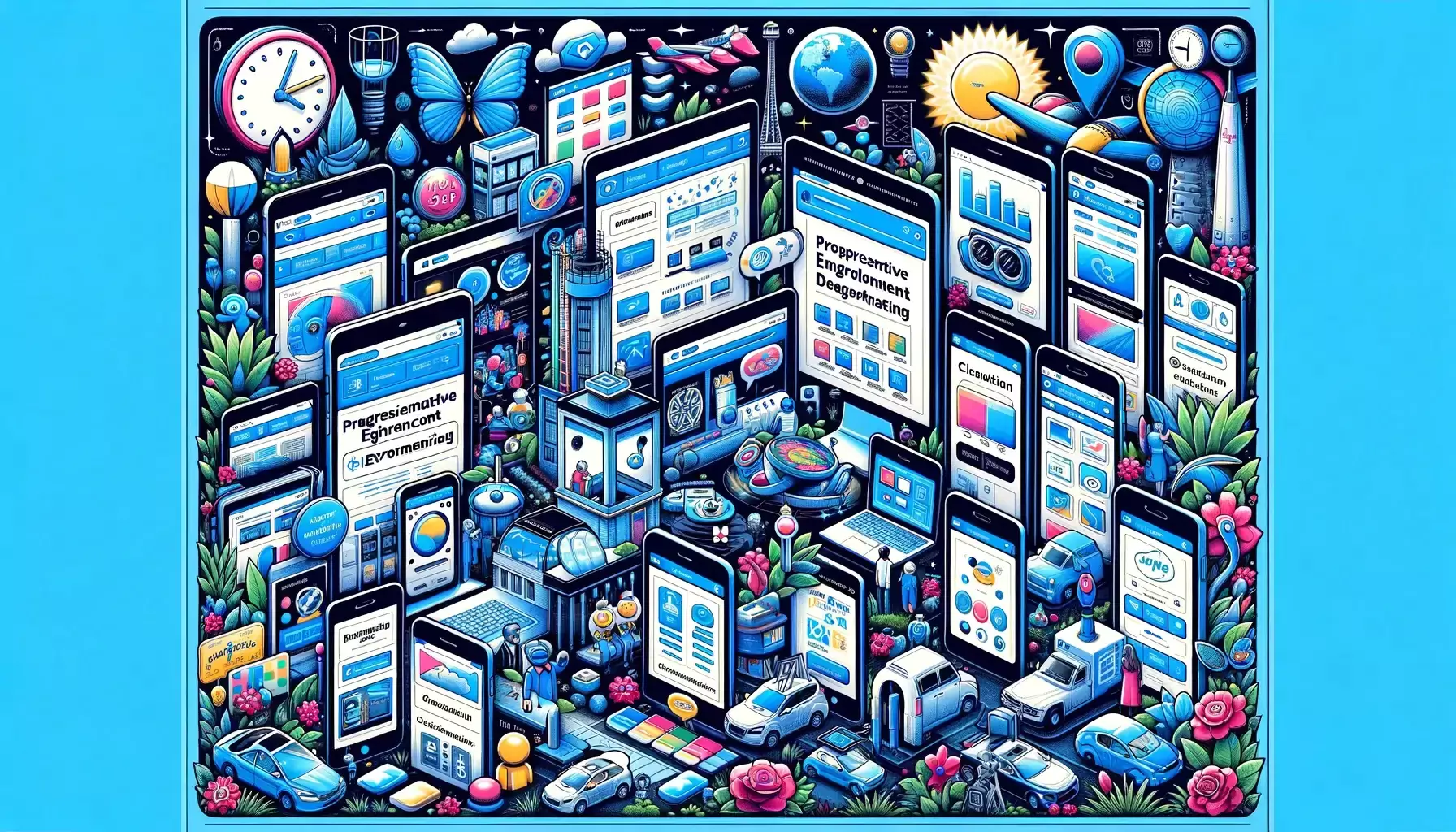
Some case studies would illustrate better how these two principles—Progressive Enhancement and Graceful Degradation—actually work at the more practical level of web design and development. The following concrete examples demonstrate how these two approaches have been implemented, what challenges were faced, and under what scenarios they bore fruit in different situations.
Case Study 1: Government Website Overhaul for Accessibility
A comprehensive modern design and official access of a national government website implemented to effectively serve a wide demography, including the disabled. Delivering the system with a focus on a mobile-first design using the Progressive Enhancement methodology for enhanced accessibility of content and usability of multi-device capabilities.
Challenge: The site had to serve a diverse user base, including older demographics not using the latest technology.
Solution: The developers used semantic HTML to add structured content in a logical order. They added CSS for styling the look of the site, and finally added JavaScript for interactive site elements. They always made sure that even when JavaScript was turned off, it would still be possible to use the site.
Impact: In such a scenario, the rebuilt website was perceived with a high degree of satisfaction and involvement of the user groups having accessibility requirements, thus outlining the importance of adopting the Progressive Enhancement approach in devising inclusive digital environments.
Case Study 2: E-commerce Platform Enhancements
For example, an e-commerce website will have sophisticated capabilities, such as real-time previews of product configuration, and so on, while knowing very well not all its users will have supporting browsers. The development team had implemented Graceful Degradation.
Challenge: Build out an immersive, interactive feature to custom-build the product experience without alienating users on older devices or browsers.
Solution: It had been developed with a full suite of features available to modern browsers, while fallback solutions—ranging from static images to simpler interaction models—had been offered to those using less capable technologies.
Outcome: The usability scores of the e-commerce platform were high, and the advanced features encouraged better user engagement; therefore, conversion rates for users of supported devices were higher.
Case Study 3: Educational Content Portal
This was a website that tried to act as an educational portal, with thousands of video lessons, interactive quizzes, and other downloadable resources—trying to make them available to everybody.
Challenge: How to make the educational content available in those schools where updated technology was not available and how to engage the students with interactive features.
Solution: The portal used Progressive Enhancement so that core content was reachable with very basic HTML, interactive features were used for users whose browsers could support them, with an alternative text description and simpler quiz available as a fallback.
Outcome: This was an effective way of ensuring an educational portal would reach many students, including those from less-funded schools that have little access to technology.
These case studies prove how Progressive Enhancement and Graceful Degradation are important strategies in web development, which are flexible and focus on the user.
This, therefore, means that companies and organizations have to take advantage of new technology that will enable them to realize greater experiences for all through their digital platforms. They would derive, therefore, the requirement of considering the varied needs and abilities of your user base in the process of design and development, making sure that no one is left behind in the digital age.
The Future of Web Design Strategies
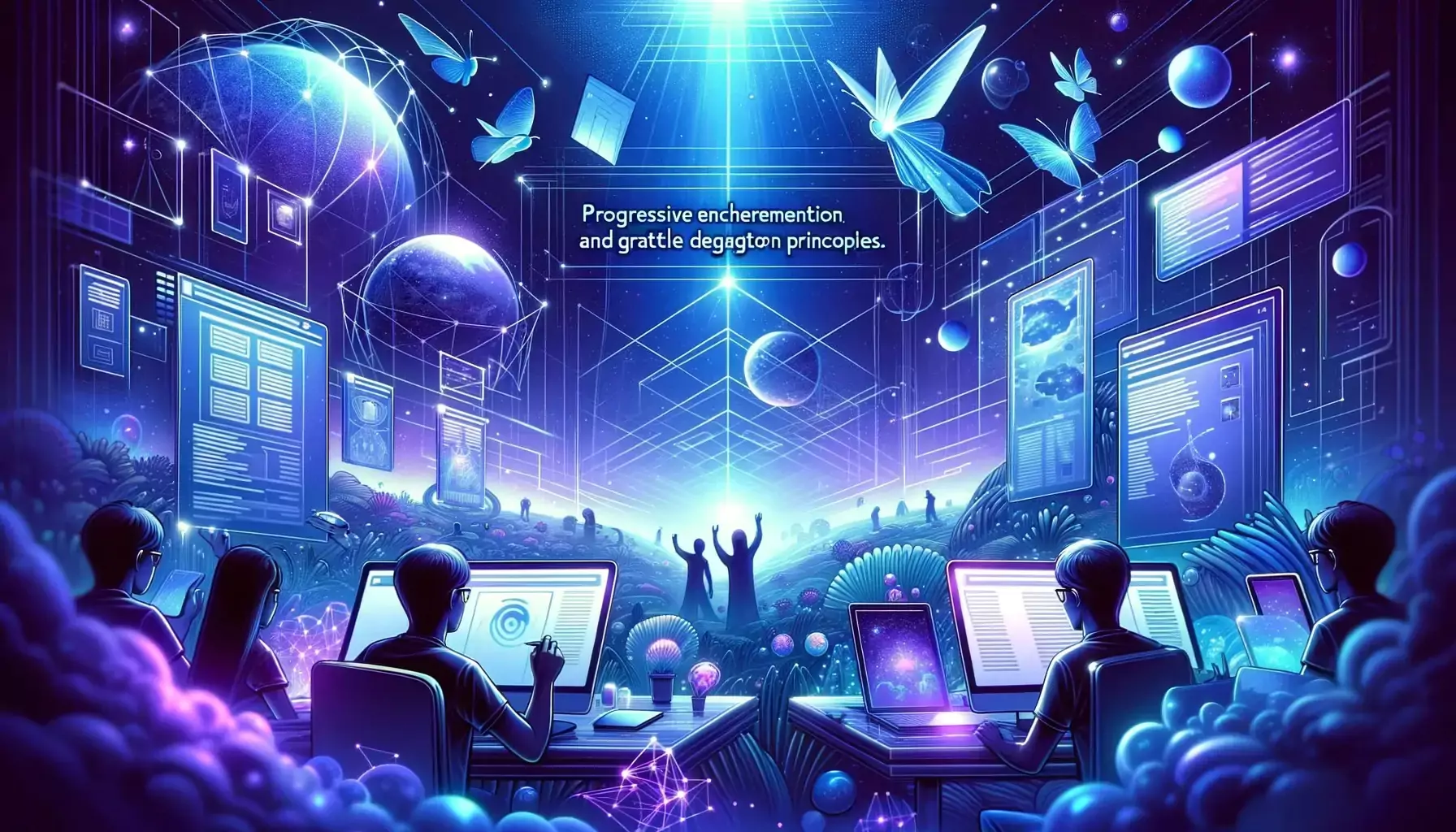
The future horizon of web designing is very promising, with new technologies and user requirements that will simply redefine strategies of development and design with the continued progress. Some very vital trends and technologies that will most likely have an influence on the future of web designing include Progressive Enhancement and Graceful Degradation strategies. Taken together, these exciting future directions will likely revolutionize not just the functionality and aesthetics of web experiences but also challenge many long-standing assumptions of how we build and interface with the web.
Emerging Technologies Shaping Web Design
- Artificial Intelligence (AI) and Machine Learning: AI and machine learning are slowly entering the world of the web design process. These technologies are said to be capable of even executing functions of design, optimizing user experience based on behavior, and even generating content by themselves. AI will be able to provide very personalized web interfaces that change content and interface based on users’ needs.
- Voice User Interfaces (VUIs): The growing number of voice-controlled virtual assistants, such as Siri, Alexa, or Google Assistant, has made VUIs one of the rising demanded and even needed interfaces. Future website designs may need to factor in optimization for voice search and natural language processing that allows for accessibility and user interaction.
- Augmented Reality (AR) and Virtual Reality (VR): AR and VR technologies are just reaching the horizon of impacting web design for the all-new, trendy type of immersive experiences, which can shake the way e-commerce, education, and entertainment websites are made. Design strategies have to change with the advent of technologies that help achieve accessible, engaging content within three-dimensional spaces.
- Internet of Things (IoT): As web-connected devices become more common, there will be a need for web design strategies that cater to a more extensive ecosystem of screens and interfaces—from smartwatches to fitness trackers to home appliances, design across any device type will need to be flexible and responsive.
Evolving User Expectations
- Privacy and Security: All this assumes more importance in the present era, where data privacy and security assume such great relevance, for web designs to evoke trust in users. This will include data usage policies, secure connections, and designs that allow easy control of personal information by users.
- Sustainability: The environmental impact of digital products may soon become a prime concern for many users. That’s where sustainable web design—that can save energy and reduce the carbon footprint of the given website, possibly extending its life before the next big redesign is necessary—comes in.
- Inclusivity: A whole added section to inclusivity in web design extends from accessibility to allow for the larger scope of human experiences and conditions. From concerns regarding mental health and cultural-related sensitivities, this even deals with other considerations regarding even subtler aspects of accessibility.
Therefore, the future of web design is purely a field of convergence and innovation—the way emerging technologies converge with developing user expectations will draw new strategies in making sure to implement engaging, effective, and inclusive web experiences.
Progressive Enhancement and Graceful Degradation will continue to play such major roles in making sure we are grounded, pushing up against the edges of what’s possible while staying principle-first in the areas of accessibility and user experience. And, how should designers and developers carry on to interpret these timeless tactics into the requirements of an arena that is regularly shifting?
Aware of these trends and open to experimenting with new tools and technologies for doing things, the web professional can always stay abreast of the times in his strategies and never become outdated or ineffective in light of what the future brings. The roadmap ahead only screams exciting with infinite prospects of inventiveness and ingenuity in designing for the web.
DM WebSoft LLP's Approach to Modern Web Design
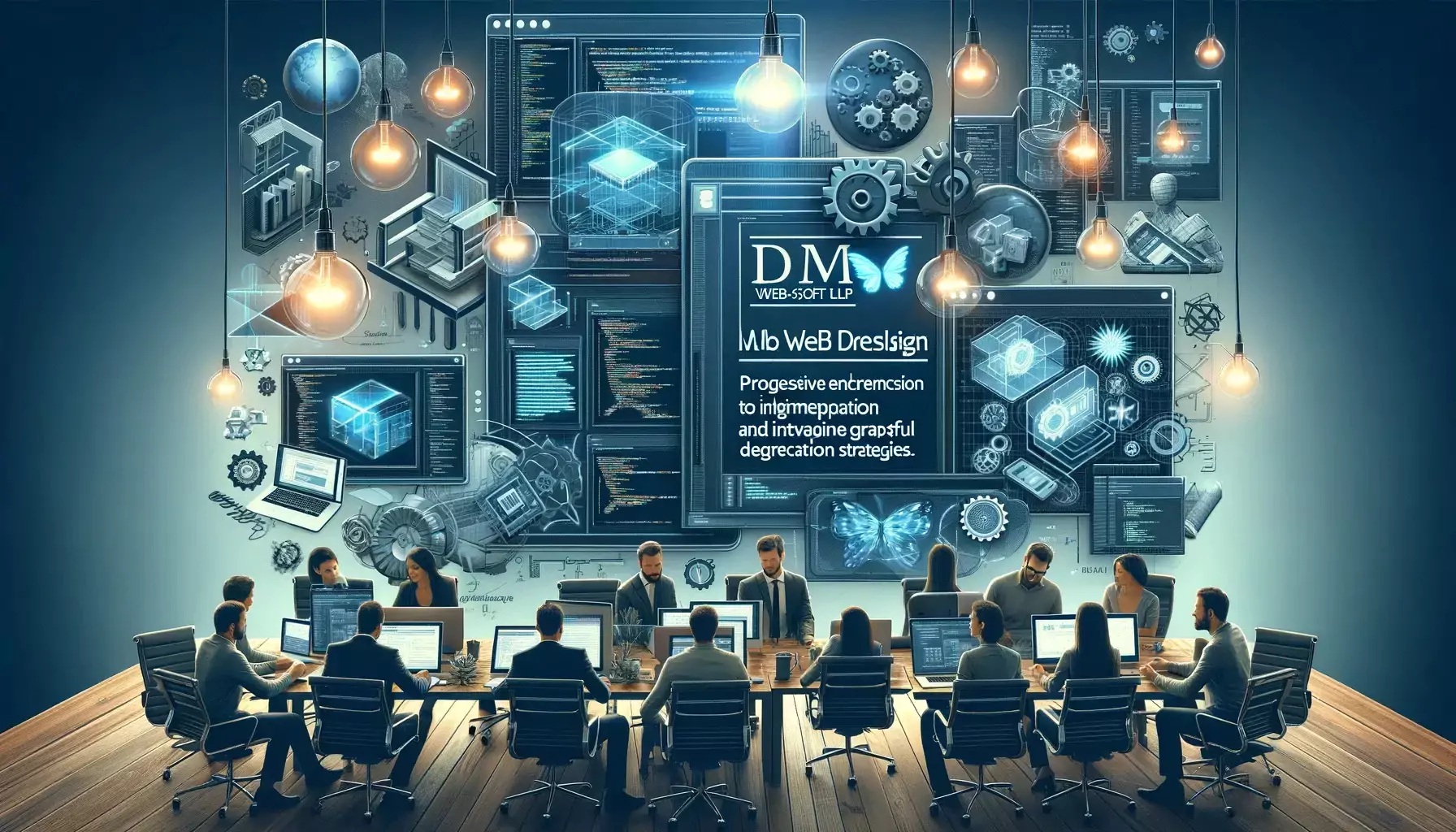
DM WebSoft LLP is one of the leaders in the new wave of web design, bringing breakthrough tactics in the creation of websites that are not just good-looking but also practical and usable. This clearly shows the fact that we are dedicated not only to being excellent by being innovative but also in the delivery of excellent web experiences to our clients and audiences interacting with the same. The next shows the basic principles and practices of our approach to modern web design. This is discussing how we have implemented the idea of progressive enhancement and graceful degradation, among other tactics, to reach our goals.
Embracing a Holistic Design Philosophy At DM WebSoft LLP, we believe in the kind of web design that keeps the user at prime importance. From this, sprouts the source of our design philosophy: understanding that a website is way, way more than a sum of pages. It is a dynamic interface through which interaction happens between the brand and the audience.
The name says it all; that is to say, this approach informs each and everything from the initial concept through the final deployment in our design and development process.
Progressive Enhancement as a Foundation
Our web development projects are based on the underlying principle of progressive enhancement strategy. This way, we can come up with websites offering service to the largest possible number of users, where each and every user from whatever device or browser platform is able to access the content and services required.
Where this strong foundation in semantic HTML, styled with CSS, and made performant, accessible, and fun with JavaScript means that our websites absolutely rock.
- Accessibility and SEO: We will also make their work concerning search engine optimization (SEO) of our websites easy by ensuring that, from the very beginning, content is accessible and semantic markup is done.
- Performance Optimization: We make sure with the use of modern technologies and best practices of performance optimization that the website developed by us loads fast and runs without jerking on all devices. To provide a good experience for the user and retain the visitor on your site, it is required.
Graceful Degradation for Cutting-Edge Experiences
Where Progressive Enhancement ensures that the accessibility is still made possible, it is using the principle of Graceful Degradation so that we can push the boundaries of web design and give leading-edge experiences to those users experiencing our sites on newer browsers.
It was so that we could use the cutting edge of web technologies and design trends at the same time offering fallbacks for ancient browsers.
Our team designs these experiences from scratch, ensuring that they degrade gracefully and all users end up with a cohesive and functional solution—though some of the fancier bits might not be supported in their device or browser. We specialize in researching and developing outstanding, innovative design and development solutions that would push the website, and accordingly its users, into experiences unmatched by any of your competitors.
- Testing and Optimization: This is so, as usually we do intense testing across the device and browser spectrum in what is usually referred to as graceful degradation, all aimed at ensuring that core functionality and accessibilities are actually maintained.
- Looking Ahead: Adapting to Future Trends DM WebSoft LLP is keenly following to be updated with the latest trends in website design and development. We searched for newer technologies, trends, and best practices that would ensure that our web designs do not get archaic and irrelevant.
We are a learning and adapting team; our dedication is to make our clients know that we are always at the leading front of giving them innovative solutions to emergent needs by their users. At DM WebSoft LLP, we emphasize the essence of modern web design with user-based design, accessibility, performance, and relentless innovation.
We incorporate strategies into practice, including Progressive Enhancement and Graceful Degradation, to ensure that when we design websites, we do not only design aesthetic websites but also develop minimal limitations functional websites. We look forward to all the new possible openings that new technologies and design philosophies bring forth with a firm focus on getting the best out of these developments for the interest of our clients, and, by extension, their audiences. This approach has put DM WebSoft LLP into a leading position in the field of web design and development, which reflects our dedication to excellence and commitment toward the deliverance of nothing but the best experiences with the web.
Call to Action
Conclusion
In stepping across the boundaries of this forward-looking web design and development landscape, Progressive Enhancement, and its counterpart, Graceful Degradation, are the strategic key. These are not just technical tactics. No, they are philosophies: one is the base for keeping the web available, operational, and interesting for all its users, independently of the capabilities of their devices and the browsers they use.
This journey from understanding these concepts to practical application in projects like that of DM WebSoft LLP undertakes a commitment within the web development community to ideals that embrace inclusivity, performance optimization, and creating immersive user experiences uncompromising in accessibility and functionality.
What stands out from Progressive Enhancement, then, is its user-first approach: It ensures the content can be accessed by anyone, hence benefiting from the improvement of SEO and the reach of the audience, while complying with web standards. All this is complemented by Graceful Degradation, ensuring that even as we push the envelope with new technologies and design innovations, we don’t alienate the users who might be on older technology. This balanced approach will make sure that the web is a place for all and becomes the place for new ideas to flourish.
In the years to come, the principles of Progressive Enhancement and Graceful Degradation are going to govern the strategies of web design. The modern web is in a continuous state of change. Thus, it is absolutely essential to the growth of new technologies, user expectations, and global challenges that philosophies of design be adaptable and thoughtful. The ability to build websites not only with leading technology but also with universal access will define the next generation of website development.
In conclusion, the further exploration of Progressive Enhancement and Graceful Degradation denotes a path for web experiences as inclusive as it denotes innovative. The future of web design is bright, with every website catering to the needs of all their users by offering content that is meaningful, engaging, and accessible. Working with this strategy implies working not just for the future of the web, rather than an enabled, operational, and forward-looking future.
The first ideology: Progressive Enhancement is the foundational development strategy in which websites have been designed and developed from a core experience viewable to all users, regardless of their browser capabilities, and then progressively enhanced for users whose browsers or features allow it. Graceful degradation, on the other hand, focuses on the experience and the user interface of the content.
Graceful Degradation is the opposite approach to Progressive Enhancement. It starts with a site designed for today’s and most able browsers, and provides for fallbacks or simplification of functionality for older browsers or devices. It aims even at enabling those users who would not access all the features to at least be in a position to use the basic functions of the site.
These strategies empower developers to be able to create a full-featured, inclusive web experience that is usable by all, no matter who the user is or what kind of device is used to access the site. The research grants businesses a wider audience; they get better SEO and enhance user satisfaction and involvement by serving all users on the website.
Yes, these strategies can be employed together in web development. While each starts from different points of approach to design, they both ensure that whatever is designed would be accessible and would offer a user experience approach that is more positive. They can work for a super, cool, accessible website for developers and users on old or less capable devices.
The elegant progressive development approach of DM WebSoft LLP, passionate in semantic HTML, is graceful with its solid rock foundation at its core but encouraging with CSS and JavaScript enabled for browsers, aiming toward holistic design philosophy. Accessibility, performance optimization, and innovation solutions are what the firm breathes in order to build the most cutting-edge websites accessible to a wide public, clearly bearing out the spirit of user-centric design and innovation.
Get Started Now !
What’s the Process ?
Request a Call
Consultation Meeting
Crafting a Tailored Proposal
Get Started Now !
Real Stories, Real Results. Discover What Our Clients Say

Working with DM WebSoft LLP was a game-changer for our business. Their technical prowess and innovative solutions transformed our online presence. A highly recommended web development agency with a stellar track record.

We are thrilled with the results DM WebSoft LLP delivered. Their deep understanding of web development coupled with years of expertise ensured a seamless and visually stunning website. True professionals!

In a digital age where first impressions matter, DM WebSoft LLP crafted a website that speaks volumes. The team’s attention to detail and commitment to quality set them apart. Thank you for making our vision a reality.

DM WebSoft LLP’s team demonstrated unparalleled expertise. Their ability to navigate complex technical challenges with ease is truly commendable. Choosing them for our web development needs was the best decision.

Exceptional service, unmatched skills! DM WebSoft LLP stands out as a leading web development agency. Their collaborative approach and commitment to excellence make them our go-to partner for all things web-related.

DM WebSoft LLP turned our ideas into a digital masterpiece. The seamless communication and timely delivery of our project showcased their professionalism. Highly impressed with the level of creativity and skill.

Our experience with DM WebSoft LLP was nothing short of amazing. From concept to execution, their team provided top-notch web development services. A reliable partner for businesses looking to elevate their online presence.

DM WebSoft LLP’s team of tech experts is second to none. Their wealth of experience reflects in the quality of their work. Our website not only meets but exceeds industry standards, thanks to their dedication.

Choosing DM WebSoft LLP was the best investment for our web development needs. Their team’s proficiency, coupled with a customer-centric approach, made the entire process smooth and enjoyable. A pleasure to work with!



